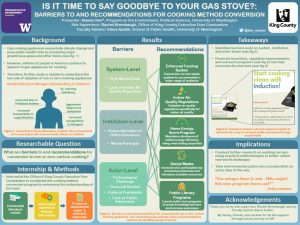Is It Time to Say Goodbye to Your Gas Stove?: Barriers to and Recommendations for Cooking Method Conversion
Studies have shown that cooking appliances are one of the sources of major greenhouse gases such as methane and nitrogen dioxide, which exacerbates climate change and puts public health at risk by posing health risks when inhaled. Low or zero carbon cooking equipment such as the conventional electric stoves and the induction stoves are available on the market. However, millions of homes in America continue to depend on gas appliances for cooking. This research aimed to identify the barriers to conversion from gas to low or zero-carbon cooking equipment and provide recommendations addressing the identified barriers for King County. To accomplish this task during my internship with King County, I conducted extensive literature reviews and three interviews with experts. All the research findings were compiled to create a Cooking Methods, Climate, and Health assessment paper and sample outreach materials for the King County to use as a starting point to promote the cooking method conversion. The findings showed systematic, institutional, and actor-level barriers to the cooking method conversion, which can be overcome through political, institutional, and financial recommendations. The identified barriers to the cooking method conversion exist on multiple levels, and interdisciplinary actions are necessary to overcome the barriers and increase cooking method conversion successfully. The increase in cooking method conversion will have long-term environmental benefits by reducing the county’s greenhouse gas emissions and also have public health benefits by eliminating the potential health risk factor.
